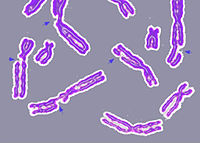
Photo from wikipedia
DNA is constantly attacked by different damaging agents; therefore, it requires frequent repair. On the one hand, the base excision repair (BER) system is responsible for the repair of the… Click to show full abstract
DNA is constantly attacked by different damaging agents; therefore, it requires frequent repair. On the one hand, the base excision repair (BER) system is responsible for the repair of the most frequent DNA lesions. On the other hand, the formation of poly(ADP-ribose) is one of the main DNA damage response reactions that is catalysed by members of the PARP family. PARP1, which belongs to the PARP family and performs approximately 90% of PAR synthesis in cells, could be considered a main regulator of the BER process. Most of the experimental data concerning BER investigation have been obtained using naked DNA. However, in the context of the eukaryotic cell, DNA is compacted in the nucleus, and the lowest compaction level is represented by the nucleosome. Thus, the organization of DNA into the nucleosome impacts the DNA-protein interactions that are involved in BER processes. Poly(ADP-ribosyl)ation (PARylation) is thought to regulate the initiation of the BER process at the chromatin level. In this review, we focus on the mechanisms involved in BER in the nucleosomal context and the potential effect of PARylation, which is catalysed by DNA-dependent PARP1, PARP2 and PARP3 proteins, on this process.
Journal Title: Advances in experimental medicine and biology
Year Published: 2020
Link to full text (if available)
Share on Social Media: Sign Up to like & get
recommendations!